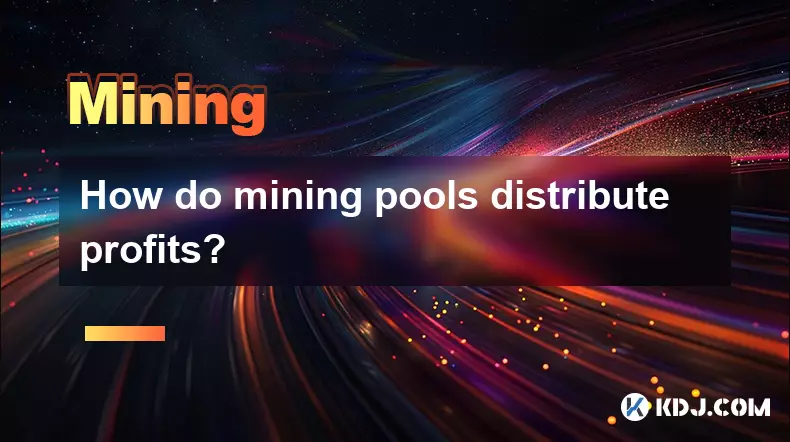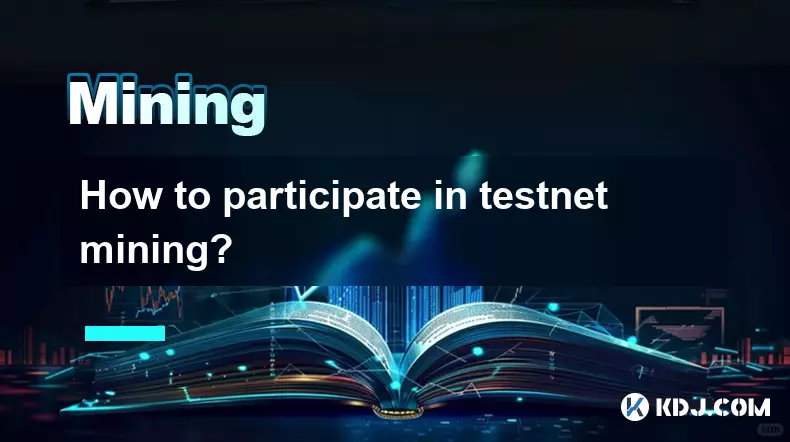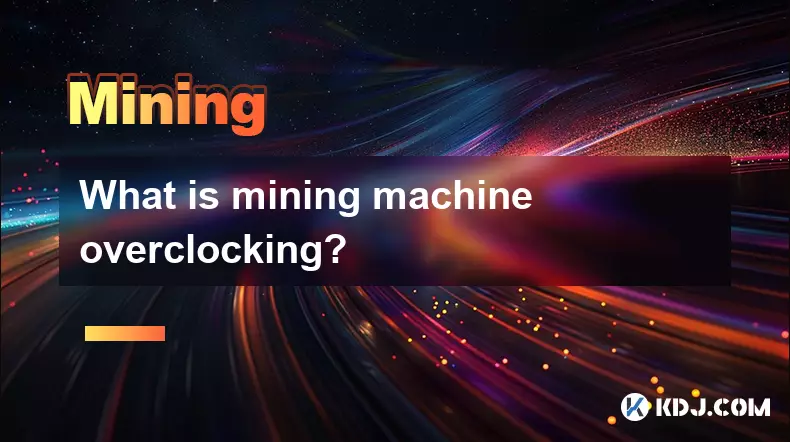-
 bitcoin
bitcoin $109667.069529 USD
-3.03% -
 ethereum
ethereum $3936.685804 USD
-4.07% -
 tether
tether $1.000493 USD
0.01% -
 xrp
xrp $2.771823 USD
-4.74% -
 bnb
bnb $957.805027 USD
-5.34% -
 solana
solana $196.735100 USD
-6.68% -
 usd-coin
usd-coin $0.999727 USD
-0.01% -
 dogecoin
dogecoin $0.227355 USD
-5.12% -
 tron
tron $0.335205 USD
-0.81% -
 cardano
cardano $0.779256 USD
-3.59% -
 ethena-usde
ethena-usde $0.999900 USD
-0.06% -
 hyperliquid
hyperliquid $42.492095 USD
-6.61% -
 chainlink
chainlink $20.501853 USD
-4.34% -
 avalanche
avalanche $28.952606 USD
-11.21% -
 stellar
stellar $0.356038 USD
-3.93%
How do mining pools distribute profits?
Mining pools distribute rewards based on contributed work, with models like PPS, Proportional, and PPLNS balancing risk, fairness, and incentives differently.
Sep 20, 2025 at 04:54 pm

Understanding Mining Pool Reward Structures
1. Mining pools operate by combining the computational power of multiple miners to increase the likelihood of solving a block and earning rewards. Once a block is successfully mined, the reward must be distributed among participants based on their contributed work. Different pools use various methods to calculate and distribute these rewards, each with distinct advantages and drawbacks.
2. One common method is the Pay-Per-Share (PPS) model. In this system, miners are paid a fixed amount for each valid share they submit, regardless of whether the pool finds a block. This approach offers stable income but requires the pool operator to assume the risk of variance, often resulting in higher fees.
3. Another popular structure is Proportional Rewards. Under this model, when a block is found, the reward is divided among miners in proportion to the number of shares they submitted during that mining round. Miners who contribute more shares receive a larger portion of the payout, aligning incentives with effort.
4. The Score-Based System assigns points to shares based on their age and difficulty. Older shares are weighted less to discourage miners from switching pools mid-round. Payouts are determined by a miner’s total score relative to others, promoting long-term participation and reducing pool-hopping.
5. Some pools implement the Double Geometric Method (DGM), which blends aspects of PPS and geometric models. It allows operators to control risk while offering consistent payouts. This method calculates payments using a decay factor applied to older shares, balancing fairness and financial stability for the pool.
Factors Influencing Distribution Accuracy
1. The accuracy of profit distribution depends heavily on how shares are tracked and verified. Each miner’s hardware submits proof-of-work units called shares, which must meet a certain difficulty threshold set by the pool. These shares are logged and used to determine contribution levels.
2. Network latency can affect distribution fairness. Miners with high ping times may experience delayed submission of shares, leading to potential undercounting or rejection. Pools often apply latency corrections or exclude excessively delayed submissions to maintain equity.
3. Share difficulty settings play a crucial role. Some pools allow variable difficulty, letting miners choose how frequently they submit shares. Higher difficulty means fewer but heavier shares, which can simplify accounting but may skew distribution if not normalized properly across participants.
4. Pool operators utilize cryptographic auditing tools to ensure transparency. Real-time dashboards display individual hashrate, accepted shares, and estimated earnings. This visibility helps miners verify that their contributions are being recorded accurately.
5. Malicious behavior, such as submitting invalid shares or attempting double submissions, is detected through signature validation and timestamp analysis. Invalid attempts are discarded, preserving the integrity of the reward calculation process.
Impact of Pool Size and Fee Models
1. Larger pools typically find blocks more frequently due to greater collective hashrate, leading to more consistent payouts for members. However, increased size often correlates with higher operational fees, reducing net returns despite regular income.
2. Fee structures vary widely, ranging from flat percentages to dynamic models based on service usage. A typical fee ranges between 1% and 3%, deducted before distributing the block reward. Some pools offer lower fees in exchange for reduced support or features.
3. Pools may charge additional fees for services like instant payouts, API access, or advanced statistics. These optional costs can accumulate, especially for high-frequency traders or automated mining operations relying on real-time data.
4. Smaller pools might adopt PPLNS (Pay Per Last N Shares), where rewards depend on the last N shares submitted before a block is found. This model benefits loyal miners who stay online consistently, discouraging short-term hopping to chase immediate gains.
5. Geographic distribution of miners influences both profitability and distribution timing. Pools with globally dispersed nodes reduce synchronization delays, ensuring fairer attribution of shares and minimizing disputes over credit allocation.
Frequently Asked Questions
What is a 'share' in cryptocurrency mining?A share is a unit of proof-of-work completed by a miner that meets the pool’s target difficulty. While not sufficient to solve a block, it demonstrates participation and effort toward finding a valid solution.
How do pools prevent miners from cheating?Mining pools use cryptographic verification to validate each share. Duplicate submissions, invalid hashes, or out-of-sequence work are automatically rejected. Continuous monitoring detects abnormal patterns indicative of manipulation.
Why do some pools pay differently even with the same hashrate?Differences arise from reward models, fee structures, and share counting mechanisms. A miner using PPS will see steadier income than one on PPLNS, even with identical hardware performance, due to how rewards are calculated over time.
Can miners switch pools without losing earnings?Miners can switch at any time, but doing so may impact earnings depending on the reward system. In PPLNS, leaving early means forfeiting credit for shares submitted just before a block was found, reducing potential payout.
Disclaimer:info@kdj.com
The information provided is not trading advice. kdj.com does not assume any responsibility for any investments made based on the information provided in this article. Cryptocurrencies are highly volatile and it is highly recommended that you invest with caution after thorough research!
If you believe that the content used on this website infringes your copyright, please contact us immediately (info@kdj.com) and we will delete it promptly.
- Riding the Crypto Wave: Ether Supercycle, Circle's Reversibility Debate, and Aster's DEX Surge
- 2025-09-27 02:45:12
- Shiba Inu's ETF Dreams: Navigating US Market Conditions
- 2025-09-27 03:05:12
- Dogecoin's Wild Ride: From Mining Moves to Meme Coin Mania – Can DOGE See 70x Growth?
- 2025-09-27 03:05:12
- Solana, Ruvi AI, and Institutional Backing: Navigating the Crypto Landscape
- 2025-09-27 02:25:16
- Momentum, Yield Campaigns, and Liquidity Expansion: Decoding the Latest Trends
- 2025-09-27 03:45:13
- Quant, CBDCs, and Crypto: Decoding the Future of Finance, Ya Heard?
- 2025-09-27 02:45:12
Related knowledge

The difference between staking and mining
Sep 24,2025 at 05:18am
Understanding Staking in the Cryptocurrency Ecosystem1. Staking involves holding funds in a cryptocurrency wallet to support the operations of a block...

How to participate in testnet mining?
Sep 22,2025 at 09:18am
Understanding Testnet Mining in the Crypto Ecosystem1. Testnet mining is a method used by blockchain developers to simulate real-world conditions on a...

How to dispose of abandoned mining machines?
Sep 19,2025 at 08:19pm
Assessing the Condition of Abandoned Mining Rigs1. Begin by inspecting each mining machine for visible damage, corrosion, or missing components. Machi...

How to identify high-quality mining pools?
Sep 21,2025 at 03:19pm
Reputation and Track Record1. A mining pool’s reputation is built over time through consistent performance and transparency. Pools that have operated ...

Advantages of decentralized mining pools
Sep 20,2025 at 04:36pm
Enhanced Security and Resistance to Censorship1. Decentralized mining pools operate on blockchain-based smart contracts, eliminating the need for a ce...

What is mining machine overclocking?
Sep 21,2025 at 07:19pm
Understanding Mining Machine Overclocking1. Mining machine overclocking refers to the process of increasing the operating frequency of a cryptocurrenc...

The difference between staking and mining
Sep 24,2025 at 05:18am
Understanding Staking in the Cryptocurrency Ecosystem1. Staking involves holding funds in a cryptocurrency wallet to support the operations of a block...

How to participate in testnet mining?
Sep 22,2025 at 09:18am
Understanding Testnet Mining in the Crypto Ecosystem1. Testnet mining is a method used by blockchain developers to simulate real-world conditions on a...

How to dispose of abandoned mining machines?
Sep 19,2025 at 08:19pm
Assessing the Condition of Abandoned Mining Rigs1. Begin by inspecting each mining machine for visible damage, corrosion, or missing components. Machi...

How to identify high-quality mining pools?
Sep 21,2025 at 03:19pm
Reputation and Track Record1. A mining pool’s reputation is built over time through consistent performance and transparency. Pools that have operated ...

Advantages of decentralized mining pools
Sep 20,2025 at 04:36pm
Enhanced Security and Resistance to Censorship1. Decentralized mining pools operate on blockchain-based smart contracts, eliminating the need for a ce...

What is mining machine overclocking?
Sep 21,2025 at 07:19pm
Understanding Mining Machine Overclocking1. Mining machine overclocking refers to the process of increasing the operating frequency of a cryptocurrenc...
See all articles










































































